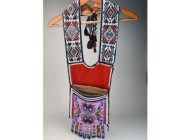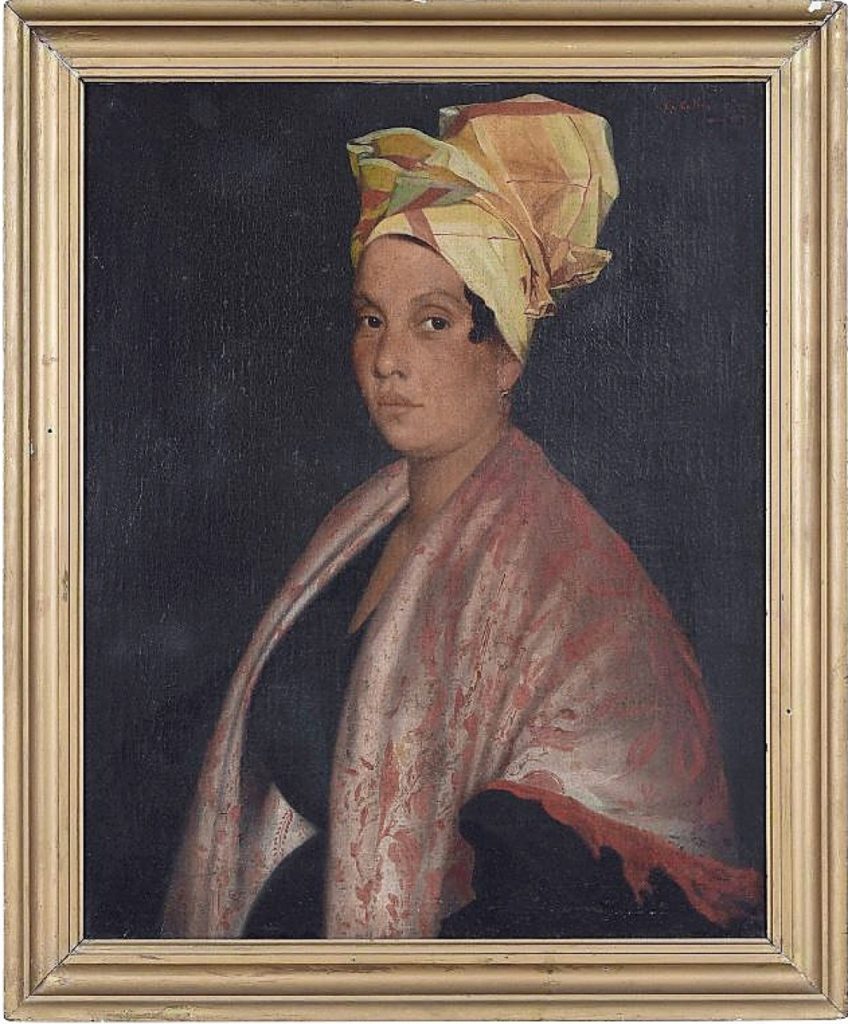
Historically known as a portrait of voodoo priestess Marie Laveau, this unattributed early Nineteenth Century painting cast a spell over private collectors and institutions from around the country. The Virginia Museum of Fine Arts won the iconic work for $984,000 ($200/300,000).
Review by Madelia Hickman Ring, Photos Courtesy Brunk Auctions
ASHEVILLE, N.C. – Led by an unattributed portrait of an unidentified sitter who has historically been considered to be that of Marie Laveau, Brunk Auctions’ May 19-21 Emporium and Premier sales achieved a total of $2.8 million with 88 percent of the 1,195 lots finding new homes.
There was magic in the sale, largely surrounding the portrait of Marie Laveau, a voodoo priestess in New Orleans in the early Nineteenth Century. Recently rediscovered in a Florida private collection having descended in a New Orleans family, the painting had at one time been on loan to the Louisiana State Museum. There, a copy was made by Frank Schnieder that is, according to Brunk Auctions’ American Fine Art specialist, Nan Zander, the museum’s most requested image.
“[The portrait] is well known and well loved. It’s a testament to how important people in New Orleans felt she was,” Zander said.
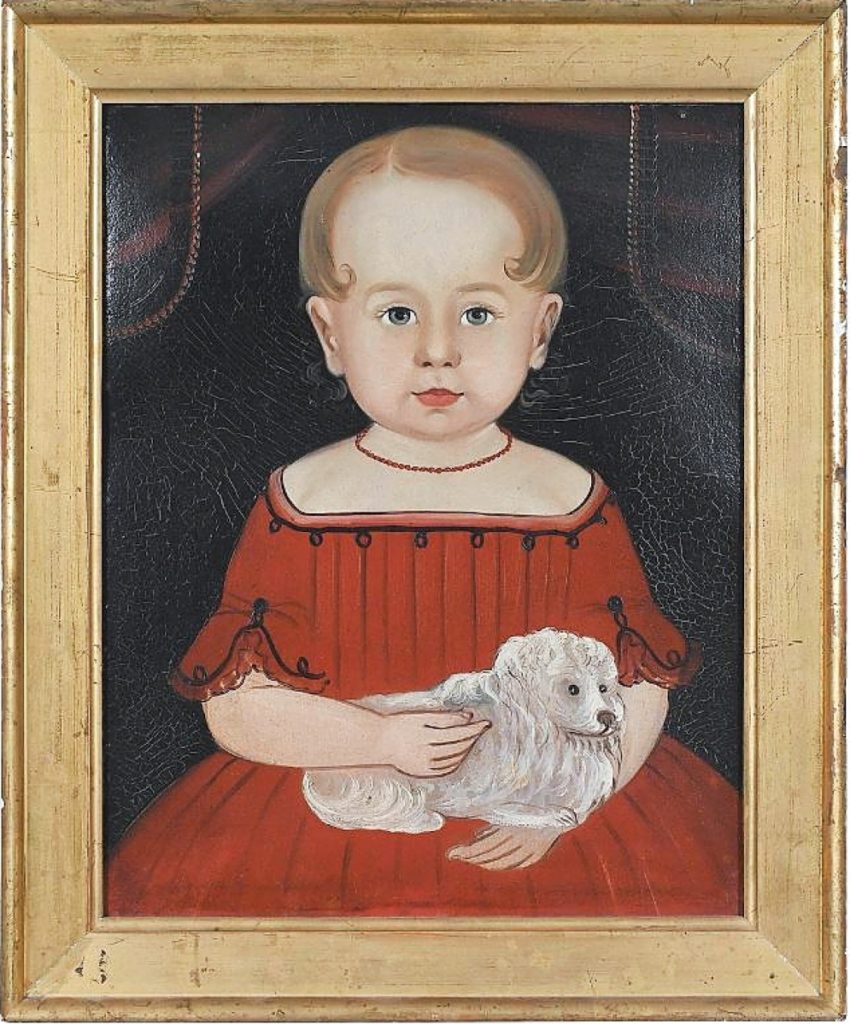
“That was a sweet thing,” Nan Zander said of this portrait of a young girl with her dog that was attributed to William Matthew Prior (Massachusetts/Maine, 1806-1873). At one time, it had been handled by Newman Galleries/Old Print Shop and sold to a private collector on the phone for $34,440 ($30/50,000).
The portrait was signed and dated “G. Catlin Nlle Orléans /mai 1837” but Zander said the attribution to George Catlin had been largely discounted and the identity of the sitter was not proven to be that of Laveau. Brunk Auctions was careful to catalog it without an attribution and as a “rare early Creole portrait.” Nonetheless, the striking portrait of a black woman in New Orleans prior to the Civil War was compelling enough to captivate interest from around the country and not one but multiple institutions, private collectors and one trade buyer. In the end, the Virginia Museum of Fine Arts (VMFA) in Richmond, underbid by an undisclosed institution, won it for $984,000.
“We are really thrilled about it,” Susan Rawles, the VMFA’s Elizabeth Locke associate curator of American decorative arts said by phone after the sale. “We have no Louisiana Territory works in our collection, so it fills a longstanding gap.”
Rawles added that research now points to an attribution to the painter Jacques Amans (1801-1888) based on matching drawing grids to outline facial features as well as similarities between the original stretcher and canvas of this painting and another known to have been painted by Amans. “There’s nothing to suggest that it’s Marie Laveau” was her response when asked who she thought the sitter was but confirmed that the department hoped it would find a place in the museum’s permanent galleries as soon as possible.
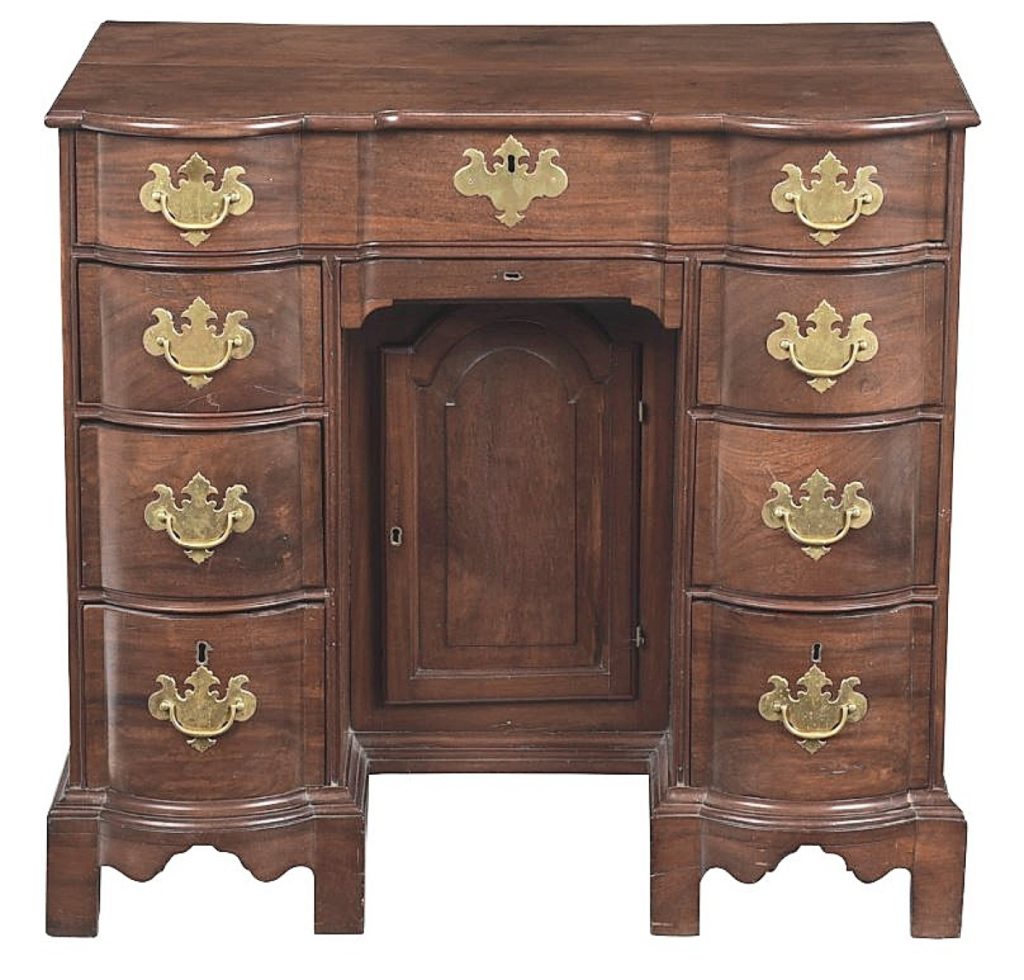
An inscription — “E. Hovay?, 1760 Made” — on the underside of this Boston Chippendale figured mahogany kneehole dressing table, circa 1760, found a new home with a trade buyer, who paid $13,530 for it ($5/7,000).
A voodoo priestess might be a hard act to follow.
Five works by Kentucky artist Henry Lawrence Faulkner (1924-1981) were offered consecutively in the middle of the session with one of them – “Cat Carrier” – achieving an exceptional $36,900, a surprising result given the lot’s $4/6,000 estimate. It was a high enough price to rank as one of the top prices in the sale and more than the other Faulkner works, though his “Garden for Tennessee Williams” followed closely at $31,980.
A surprisingly strong result in the fine art section was seen with the $21,760 achieved for “Blue Mountains,” painted circa 1946-47 by Angel Botello (Puerto Rican/Haiti, 1913-1986). It was acquired from the artist by the seller’s father, a diplomat and friend of Botello, one of three paintings purchased at the time. The original owner later brought the painting to the Galeria Botello in Puerto Rico, where the artist’s widow was “thrilled to see [it].” “Blue Mountain” sold to a private collector in New York state.
The sale offered more than 80 lots that were being sold to benefit the American Folk Art Museum in New York City, an assortment of objects that ranged from paintings, carved figures, weathervanes, trade figures and signs, hooked rugs and quilts, and a tall case clock. At the head of the group was a painted cast iron figure of a standing man with outstretched arms, his chest bearing the words “Vega Cal Gets The Bile.” According to the catalog, this was a trade sign for Bessemer, Ala., pharmacist W.T. Taylor, who created and sold a liver cure at the turn of the century named VegaCal; such signs were original double sided and placed in the Birmingham, Ala., area. A trade buyer bidding on the phone paid $20,910 for it, more than five times its high estimate.
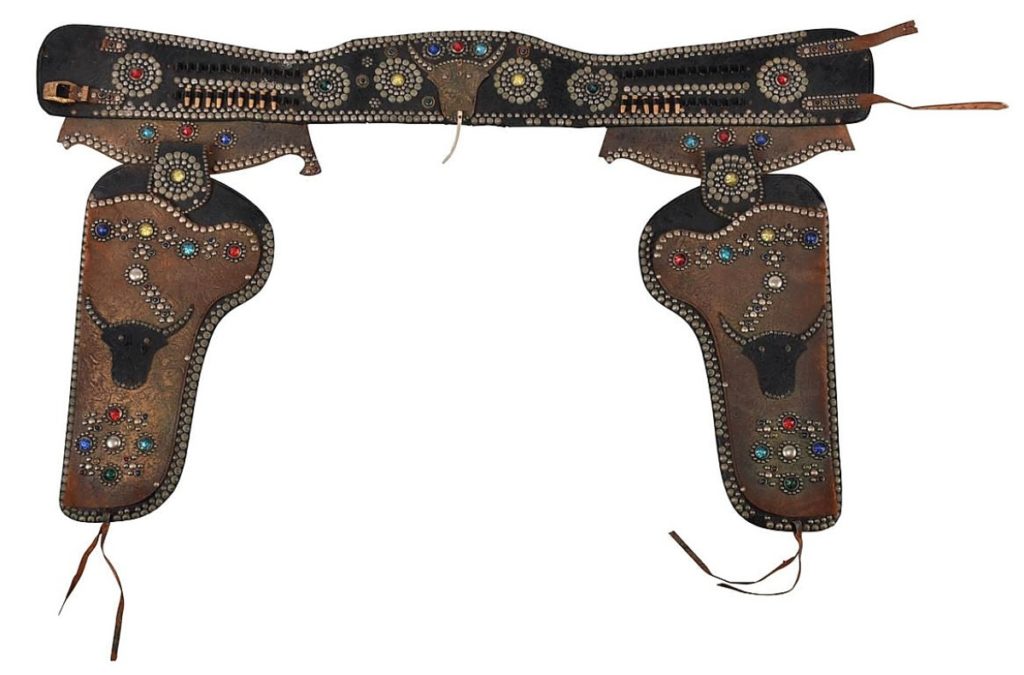
This American folk art trade sign in the form of a gun belt and holster was one of several dozen pieces sold to benefit the American Folk Art Museum. It fired up bidders, with an online buyer taking it for $5,535 ($500/700).
Two other trade signs from the American Folk Art Museum collection that realized high prices were a large gilt fish-form trade sign that measured 36 inches tall and more than 5 feet long; it swam to a new home with an online bidder for $12,160. Going out with a bang at $5,535 was a gun belt and holsters trade sign that was 58 inches long. It also sold to an online buyer.
Brunk Auctions nearly always offers works by Southern artists of any era and this sale saw as one of its highlights a North Carolina landscape by Wilhelm Frerichs (South Carolina/New York, 1829-1905) that measured 36 by 54½ inches. A trade buyer, bidding on the phone, outlasted competitors and secured it for $8,610, nearly three times its high estimate. Also exceeding expectations was “Low Country Cabin” by William Aiken Walker (American/South Carolina, 1838-1921), that had provenance to New York City’s Kennedy Galleries and the collection of John B. Schorsch. It achieved $11,070 against a $6/8,000 estimate.
Fine and decorative arts made in New England made a splash with bidders, particularly a selection of approximately 30 works from the estate of New Jersey collector Peter Pfaffenroth (1941-2020). Bringing $15,990 from a private collector online was a New England Queen Anne walnut dressing table with a recessed tromp l’oeil gilt shell that had been illustrated in the 1979 Philadelphia Antiques Show brochure and provenance to Robert Burkhardt (1894-1992) of Kutztown, Penn. It was followed at $13,530 by a Chippendale figured mahogany kneehole dressing bureau with an inscription “E. Hovay?, 1760 Made.” Rounding out the highlights from Pfaffenroth, at $4,305, was a Connecticut Queen Anne inlaid cherrywood dressing table with some repairs that a trade buyer on the phone snagged.
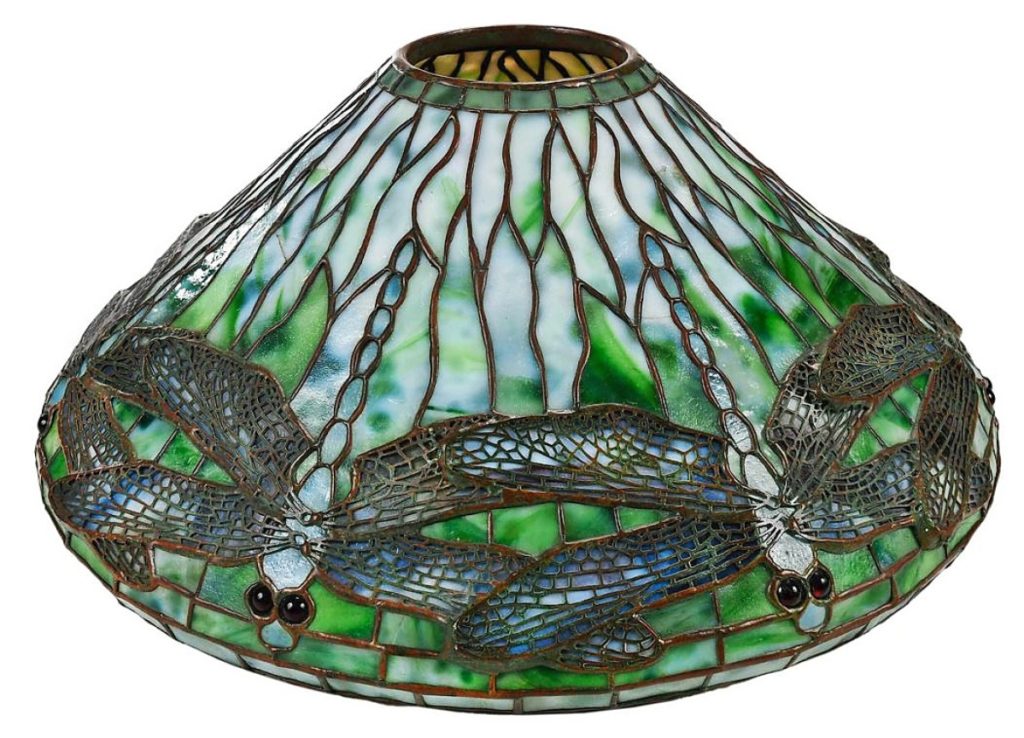
A trade buyer paid $49,200 for this Tiffany Studios, New York, circa 1910 leaded glass Dragonfly lamp shade. It was one of the highest prices in the sale ($12/18,000).
It was not from Pfaffenroth’s estate but another lot that was made in New England and typically a favorite with collectors of New England decorative arts was a portrait of a young girl with her dog, attributed to William Matthew Prior, done in oil on board measuring 17 by 13½ inches and housed in a period giltwood frame. It sold to a private collector, bidding on the phone, for $34,440.
Jewelry swept the leaderboard in the Premier Auction’s first day of sale, led by a platinum diamond ring, size 5¾, with center emerald cut 3.6-carat diamond of H color, VS2 clarity and accompanied by a GIA report. It more than doubled its low estimate and sold to an online buyer for $46,740. Another platinum diamond ring, Art Deco in style and with a 2.98-carat cushion cut diamond surrounded by 6 baguette diamonds and 18 old cut round diamonds that went out at $23,940.
In the Emporium Auction on May 19, the top lots had a Middle or Near Eastern flair, with a Persian dagger in an enamel decorated sheath, possibly Nineteenth Century, being snapped up by a European buyer for $19,680, nearly 40 times its high estimate. From Egypt, a pale green faience Ushabti figure that stood 7½ inches tall and had provenance to a Southern institution as well as the South Carolina collection of Charles M. Blackmon, brought $12,300 and also sold to a phone bidder from Europe.
Prices quoted include the buyer’s premium as reported by the auction house.
Brunk Auctions next Emporium and Premier Auctions will take place July 14-16 and September 15-17; additionally, the firm will sell the Estate of Peter Tillou on September 30.
For information, 828-254-6846 or www.brunkauctions.com.


















